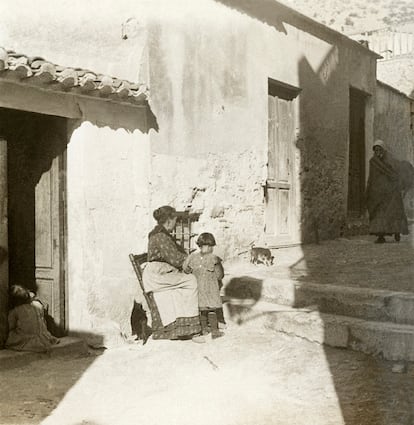The coronavirus effect: Spain sees sharp decline in births
There was a 23% fall in registered newborns in the December-January period compared with the previous year, mirroring similar trends in neighboring countries
Nine months later, experts’ forecasts are coming true: the coronavirus pandemic is causing a sharp decline in Spain’s birth rate. Between the beginning of December and the end of January, births fell by 22.6% from the same period a year earlier.
While the definitive data is not in yet, this is the first indicator of the effects of the strict home confinement during March and April of last year, when the babies born in December and January were conceived.
Civil records show that 45,054 newborns were registered during the last month of 2020 and the the first month of 2021, representing 13,141 fewer births than over the same period a year earlier. The figure is based on information from 3,929 registries offering online records, representing 93% of the population.
In the month of January alone, there were 6,889 fewer newborns registered in civil registries across Spain than in January 2020, a drop of 23%. By comparison, between January 2019 and January 2020 the decline was just 1.7%.
This trend is backed by available data from the National Statistics Institute (INE), which shows a sharp decline in births in early 2020 within a larger downward tendency. The year 2019 had already set a record with 360,617 births, the lowest annual number in the historical series that the INE began in 1941. But the first half of 2020 set a whole new record with 168,047 births, a 4.2% decline from the first half of 2019. Full figures for 2020 are not available yet.
The decline in births will add to the overall drop in Spain’s fertility rate, which has been falling for years and is now an average of 1.23 children per woman, compared with 2.8 in 1975. Women are having fewer children than ever, and having them later in life. And now, with the uncertainty caused by the coronavirus, experts expect the rate to drop even further. Nobody will venture to say by exactly how much, but everyone agrees that the crisis will last beyond a few months.
“The INE will provide the real figure, but the numbers coincide with what we’d been expecting and what we’re seeing in other countries,” explains Diego Ramiro, director of the Institute of Economics, Geography and Demographics at the National Research Council (CSIC). In December, births declined by 21.6% in Italy. In January, they dropped by 13% in France. “In some US states such as Florida, California or Hawaii, they’ve seen drops ranging from 5% to nearly 20%,” he adds.
Ramiro believes the decline will also be felt in the May 2020 figures, as people were still under a strict home lockdown. “We can expect that more children were conceived when the state of alarm ended. But with the second wave [of the coronavirus] there will probably be another delay, and again with the third wave,” he says. “It’s not a good idea to extrapolate the data from the two months of confinement to the rest of the year, but the drop will likely be sharp.”
Large hospitals such as Vall d’Hebron or Sant Pau in Barcelona saw a 10% decline in pregnant patients last year, while deliveries fell by the same rate in January and February of this year. At La Paz hospital in Madrid, there was a 14% drop in first-trimester visits by pregnant women. Other medical centers did not notice a trend change because the birthrate had already been falling before this: Sergio Castán, the head of obstetrics at Miguel Servet hospital in Zaragoza, talks about an annual drop of 5%, while Guillermo Antiñolo of Virgen del Rocío hospital in Seville says they have seen a 40% decline in baby deliveries over the last 12 years, from 9,000 in 2008 to just over 5,000 in 2020.
The 1918 flu

In terms of the fertility rate, the effects of the pandemic cannot be compared with the Spanish Civil War (1936-39). Alberto Sanz, who teaches political science and sociology at Madrid’s Complutense University, notes that the number of children per woman dropped dramatically at the time due to a series of factors, including men being sent to the front, numerous deaths, hunger and disease. But that generation had another chance to have kids, since women began bearing children at a young age. Even after the 1918 flu pandemic, the fertility rate rose quickly again at a time when contraception was not common.
But these days, Ramiro of the CSIC is not expecting the rate to spike after the pandemic ends. “Besides the epidemic crisis, we will have an economic crisis and we’ve already seen the effects of the 2008 crisis, which caused a sustained drop,” he notes. “Now we are heading into a year of slowdown and we will see the lowest fertility rates Spain has ever had.”
Teresa Castro, a demographer at CSIC, talks about a survey from March-April 2020 where half of respondents said they were delaying their plans to have children while 29% said they were dropping them altogether. “The greatest fear is job insecurity,” she notes. “Even if you don’t lose your job, you’re afraid of losing it and you decide to wait, because of the expected rise in unemployment and temporary jobs. But the young adults caught by the 2008 crisis already delayed life decisions such as moving out of their parents’ house and forming their own family. We haven’t yet gotten over that crisis, and now we’ve been hit by this one.”
Experts note that if there is a fourth wave of the coronavirus and more adverse economic conditions, youths may take even longer to move out. Improved fertility rates will depend on how the economy performs, but nobody is expecting a V-shaped recovery, notes Ramiro. The baby bust is here to stay for a while.
English version by Susana Urra.
Tu suscripción se está usando en otro dispositivo
¿Quieres añadir otro usuario a tu suscripción?
Si continúas leyendo en este dispositivo, no se podrá leer en el otro.
FlechaTu suscripción se está usando en otro dispositivo y solo puedes acceder a EL PAÍS desde un dispositivo a la vez.
Si quieres compartir tu cuenta, cambia tu suscripción a la modalidad Premium, así podrás añadir otro usuario. Cada uno accederá con su propia cuenta de email, lo que os permitirá personalizar vuestra experiencia en EL PAÍS.
¿Tienes una suscripción de empresa? Accede aquí para contratar más cuentas.
En el caso de no saber quién está usando tu cuenta, te recomendamos cambiar tu contraseña aquí.
Si decides continuar compartiendo tu cuenta, este mensaje se mostrará en tu dispositivo y en el de la otra persona que está usando tu cuenta de forma indefinida, afectando a tu experiencia de lectura. Puedes consultar aquí los términos y condiciones de la suscripción digital.
More information
Últimas noticias
There is as much life left to discover on planet Earth as that which is already known
Dozens presumed dead, around 100 injured in fire at Swiss Alps bar during New Year’s celebration
Is porn for women different from conventional porn? We spoke to those who make it
Cartagena de Indias is sinking: What can the city do to mitigate it?
Most viewed
- Reinhard Genzel, Nobel laureate in physics: ‘One-minute videos will never give you the truth’
- David King, chemist: ‘There are scientists studying how to cool the planet; nobody should stop these experiments from happening’
- Oona Chaplin: ‘I told James Cameron that I was living in a treehouse and starting a permaculture project with a friend’
- Sinaloa Cartel war is taking its toll on Los Chapitos
- The Interoceanic Train, the Mexican alternative to the Panama Canal










































